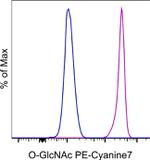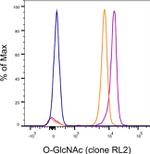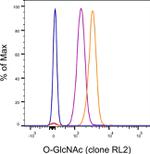Search Thermo Fisher Scientific
Invitrogen
O-GlcNAc Monoclonal Antibody (RL2), PE-Cyanine7, eBioscience™
This Antibody was verified by Cell treatment to ensure that the antibody binds to the antigen stated.
图: 1 / 3
O-GlcNAc Antibody (25-9793-42) in Flow



产品信息
25-9793-42
种属反应
宿主/亚型
分类
类型
克隆号
抗原
偶联物
激发/发射光谱
形式
浓度
纯化类型
保存液
内含物
保存条件
运输条件
RRID
产品详细信息
Description: This RL2 monoclonal antibody recognizes proteins with O-N-acetylglucosamine (O-GlcNAc) glycosylation. It was originally developed by immunizing mice with the rat liver nuclear envelopes containing nuclear pore complexes. The RL2 clone has been successfully used in Western blot, immunofluorescence, immunoprecipitation, and flow cytometry in a wide variety of mammalian cells.
Applications Reported: This RL2 antibody has been reported for use in flow cytometric analysis.
Applications Tested: This RL2 antibody has been pre-diluted and tested by flow cytometric analysis of normal human peripheral blood cells using the Foxp3/Transcription Factor Staining Buffer Set (Product # 00-5523-00) and protocol. Please refer to Best Protocols: Protocol B: One step protocol for (nuclear) intracellular proteins located under the Resources Tab online. This may be used at 5 µL (0.25 µg) per test. A test is defined as the amount (µg) of antibody that will stain a cell sample in a final volume of 100 µL. Cell number should be determined empirically but can range from 10^5 to 10^8 cells/test.
Light sensitivity: This tandem dye is sensitive to photo-induced oxidation. Please protect this vial and stained samples from light.
Fixation: Samples can be stored in IC Fixation Buffer (Product # 00-8222) (100 µL of cell sample + 100 µL of IC Fixation Buffer) or 1-step Fix/Lyse Solution (Product # 00-5333-34) for up to 3 days in the dark at 4°C with minimal impact on brightness and FRET efficiency/compensation. Some generalizations regarding fluorophore performance after fixation can be made, but clone specific performance should be determined empirically.
Excitation: 488-561 nm; Emission: 775 nm; Laser: Blue Laser, Green Laser, Yellow-Green Laser.
靶标信息
O-linked N-acetylglucosamine (O-GlcNAc) is a posttranslational modification characterized by the attachment of N-acetylglucosamine to specific serine or threonine residues. Unlike other protein glycosylations, O-GlcNAc modifications occur within the nucleus and cytoplasm. They are found on many cellular proteins, including nuclear pore, oncogene, cytoskeletal, heat shock, viral and transcription regulatory proteins. O-GlcNAc glycosylations are thought to obscure phosphorylation sites, counteracting phosphorylation-dependent signaling pathways and protein interactions.
仅用于科研。不用于诊断过程。未经明确授权不得转售。
How to use the Panel Builder
Watch the video to learn how to use the Invitrogen Flow Cytometry Panel Builder to build your next flow cytometry panel in 5 easy steps.
篇参考文献 (0)
生物信息学
蛋白别名: GlcNAc




